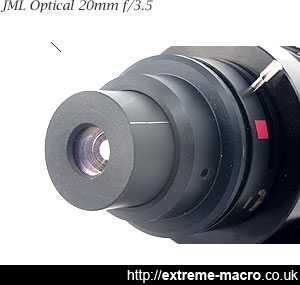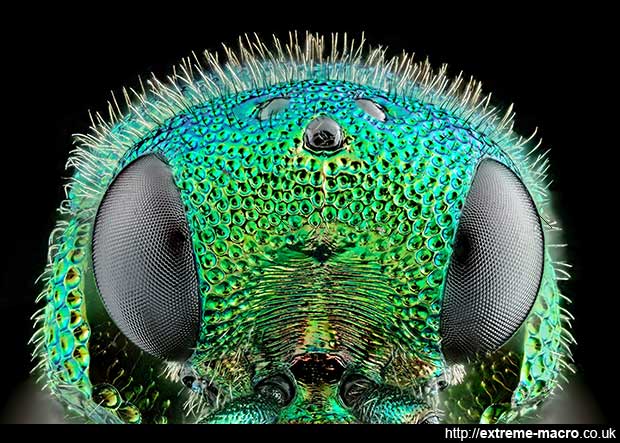JML Optical 21mm f/3.5 Review
by Johan J Ingles-Le Nobel
Last updated August 31, 2017
The JML Optical 21 mm f/3.5 lens took the extreme macro world by storm in 2010, and has since become the most highly sought after optic within extreme macro circles for macro focus stacking in the 4:1 to 7:1 magnification range. Of all the macro lenses that I own, this probably has the highest 'fetish' factor associated with it and in terms of review score, I'd have to rate it at 10/10.
500 lines/mm when object is in focusThe JML Optical 21mm f/3.5 exhibits excellent correction of all aberrations for an angle of 35 degrees without vignetting. Its resolution in focus is 385 lines/mm when the image of object is in focus (D=6mm), or 500 lines/mm when object is in focus (numerical aperture .14). JML 21 is an industrial optic, one of various non-standard optics that can be used for extreme macro.
About the JML 21mm f/3.5

The JML Optical 21mm f/3.5, a tiny slip of a lens that is good both on an infinite tube as well as on its own on bellows.
Note the scribe mark on the lens; if you purchase one, look for a copy with the scribe mark, and test your copy to determine what effect the orientation of the line has on your subject of interest.
The working distance at 7:1 of just over 10mm isn't actually that stellar, but its excellent optical quality means compromises do have to be made.
The JML 21mm f/3.5 lens contains four coated glass elements in a black aluminium case measuring, 1.15625" long by 1.0" diameter. It is believed to be JML Model Number 61580 which is no longer available, with an original list price of around $300. JML 61580 is a successor to JML models 61592 and 61594 from the 1980s. The JML Optical design diagram for the JML 21 has MAG = 0.0827, which corresponds to 12:1 reversed. But it's better to use this at lower magnification to avoid diffraction softening.
Possible applications for the JML 21mm f/3.5 include: objective lens for scanners; photographic objective enlarging lens for nearly 10:1; objective for a hand-held microscope, enlarging from 30X to 120X (numerical aperture=1.41); lens working with light sensor or emitter as a precise focusing element; or lens for shaping a laser beam.
The working distance at 7:1 is over 10mm and the lens has an integral circular fixed aperture stop installed. (taken from JML literature). This working distance at 7:1 of just over 10mm isn't actually that stellar for extreme macro, but its excellent optical quality means compromises do have to be made.
Jewel Wasp from the Americas shot with JML 21 mm. JML Optical 21 mm makes for very sharp, contrasty pictures, although the working distance does make it a challenging lens to get the best out of.
Lenses like this, designed for detector array imaging, are characterised as wide field and flat field. Typical uses for wide field flat field lenses include, but are not limited to data recording, CCD imaging, document scanning, non contact measuring, image digitising, x-ray imaging, high speed photography, pattern recognition and guidance systems; wide field and flat field are good things to look for in extreme macro lenses. Detector arrays are exotic imaging arrays used in telescopes and satellites; JML have not provided further details what this optic was intended for.
Scribe Mark
test your copy to determine what effect the orientation of the scribe line might haveAccording to a JML Optical rep, some JML 21mm f/3.5 copies come with a scribe mark (linear scratch) on the lens, to allow certain customers to rotationally align the optic to its optimum focus plane for flat line copy (type) imaging and printing applications.
If you purchase a JML 21mm f/3.5, look for a copy with the scribe mark, and test your copy to determine what effect the orientation of the scribe line might have on your particular subjects of interest.
adding a rear baffle makes a large differenceThis may be the cause of marginal copy variation that has been reported in JML 21mm f/3.5 lenses. Some copies do seem to be a frisson less sharp in the corners below 6x on a full frame DSLR.
Baffles
Although the JML 21mm f/3.5 is 'antireflection coated for maximum transmission' and constructed with 'black anodised aluminium barrels', extreme macro photographers have reported that adding a rear baffle makes a large difference. Light can reflect off the base of the lens and the adaptor even though both are black.
A rear baffle made from a circular piece of flocking material or just a metal disk painted flat black, with a round hole cut in the centre (similar to a Waterhouse stop) works well. The hole in the flocking disk should be cut just large enough to prevent vignetting.
Although it is also conceivable to add a front baffle, this might compromise what is an already short working distance. That said, I'm finding that making a small hood out of a Christmas popper works quite well, with a half a ping pong ball seated on top of that. For lighting, three flashes at 1/32 surrounding the pingpong ball gives quite good light (@ISO 100, c.4:1), but it does get very cramped round the subject with all these large flash heads surrounding the pingpong ball. And working distance is definitely tight.
Cost
The working distance at 7:1 of just over 10mm isn't actually that stellar for extreme macroJust over 100 JML 21mm f/3.5 lenses originally came onto eBay in 2010 for the princely sum of US$12, and were eagerly snapped up by the extreme macro crowd. This lens, because of its scarcity, now trades hands at prices north of US$400.
More From JML Optical
Another stellar performer from JML Optical for extreme macro photography is the JML 20x objective. This company builds outstanding optics and it would be interesting to try out some more of their industry micro lenses. If anyone from JML Optical should happen on this page, feel free to contact me and send me some!
Finding a JML 21mm
JML 21mm is difficult to source, and there are only limited quantities available now. Either ping JML Optical a mail directly, or post a WTB: here requesting one.
Related Articles




